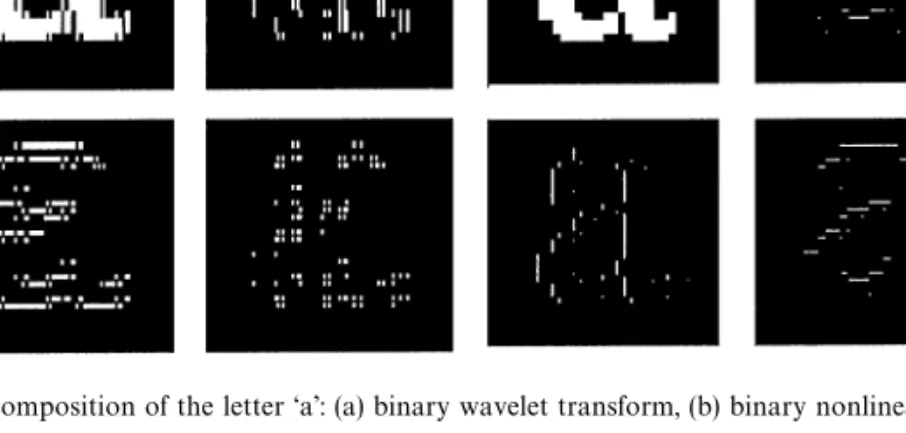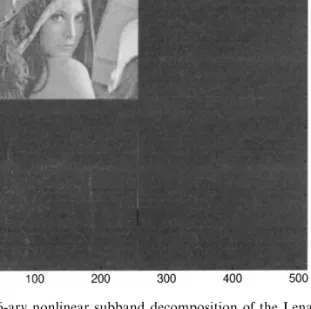* Corresponding author. Tel.: 90-312-2901477; fax: 90-312-2904307; e-mail: cetin@ee.bilkent.edu.tr.
1 This work was supported by TUBITAK (Turkish Scientific and Technical Research Council), TTGV and NSF Grant No. INT-9406954. This paper was presented in part at IEEE International Symposium on Time-Frequency and Time Scale Analysis, 17—21 June 1996, Paris, France.
Nonlinear subband decomposition structures in GF-(N) arithmetic
1
M. Nafi Gu¨rcan, O®mer N. Gerek, A. Enis C
7 etin*
Department of Electrical and Electronics Engineering, Bilkent University, Bilkent, Ankara, TR-06533, Turkey
Received 20 January 1997; revised 6 October 1997
Abstract
In this paper, perfect reconstruction filter bank structures for GF-(N) fields are developed. The new filter banks are based on the nonlinear subband decomposition and they are especially useful to process binary images such as document and fingerprint images. ( 1998 Elsevier Science B.V. All rights reserved.
Zusammenfassung
In diesem Artikel werden Filterbankstrukturen zur perfekten Rekonstruktion von GF-(N) Feldern entwickelt. Die neuartigen Filterba¨nke basieren auf der nichtlinearen subband-Zerlegung und eignen sich besonders zur Verarbeitung digitaler bina¨rer Bilder wie Abbildungen von Schriftstu¨cken oder von Fingerabdru¨cken. ( 1998 Elsevier Science B.V. All rights reserved.
Re´sume´
Cet article de´veloppe des structures en bancs de filtres a` reconstruction parfaite pour les champs GF-(N). Les nouveaux bancs de filtres sont base´s sur la de´composition en sous-bandes non-line´aire et sont particulie`rement utiles pour traiter des images binaires telles que les images de documents ou d’empreintes digitales. ( 1998 Elsevier Science B.V. All rights reserved.
Keywords: Nonlinear subband decomposition; Galois field arithmetic
1. Introduction
The subband decomposition is a widely used tool in signal processing and pattern recognition.
Tradi-tionally, linear filters with perfect reconstruc-tion (PR) property are employed for the decompo-sition. Recently, a variety of nonlinear ‘subband’ decomposition structures with perfect reconstruction
0165-1684/98/$19.00 ( 1998 Elsevier Science B.V. All rights reserved.
property have been proposed and successfully used in image compression and analysis [4,5,7—9]. The key idea is to replace the linear filters in a classical subband decomposition scheme with nonlinear ‘half-band’ filters.
In this paper, we show that the nonlinear subband decomposition structures of [4,5,8] can be imple-mented in Galois Field (GF) arithmetic. In Sec-tion 2, the Galois field concepts are reviewed. In Section 3, the nonlinear subband decomposition structure of [8] is explained and it is proved that the filter bank provides perfect reconstruction in GF-(N) arithmetic as well. In Section 4 examples of binary and 256-ary nonlinear subband decomposi-tions are presented.
2. Galois field arithmetic
A field is defined as a set with two arithmetic operations, addition and multiplication if
1. the set is closed under addition and multiplica-tion;
2. addition and multiplication are associative and commutative; and
3. the distributive law holds.
A field with a finite number of elements, q, is called a finite field or Galois field and is denoted by GF-(q) [1]. Most signal processing operations are carried out over real and complex fields whose sizes are infinite. However, binary images such as docu-ment images, fingerprint images, etc., constitute an important class and GF-(2)-based image processing is not only computationally efficient for such images but also sufficient in many applications.
The simplest Galois field is GF-(2), with the set M0, 1N, and modulo-2 addition, and multiplication. Two binary sequences u[n] and v[n] can be convol-ved in this field as follows:
c[n]"+ l
u[n!l]v[l] (modulo-2). (1)
For example, the convolution of the sequences
u"M0, 0, 1, 1N and v"M1, 1, 0, 1N in GF-(2) results
in c"M0, 0, 1, 0, 1, 1, 1N in GF-(2). If real arithmetic were used then the result would beM0, 0, 1, 2, 1, 1, 1N.
Nonlinear filtering operations can also be per-formed in GF-(2). For some morphological filtering operations such as erosion, dilation, the filter out-puts are binary for binary inout-puts [3]. Hence in such filters the output is also in GF-(2). Another impor-tant nonlinear filter is the median filter. For binary images, median filtering can be efficiently computed simply by counting the number of ones in the region of support. If the number of ones is greater than half of the number of pixels then the median value is one, otherwise it is zero. In general, if the result of the nonlinear filter is an integer different from 0 and 1 then it can still be expressed in GF-(2) after a modulo-2 operation.
The above concepts can be generalized to GF-(q), which is based on the set M0, 1,2, q!1N and modulo-q arithmetic, if q is a prime number. If q is not a prime number but an integer power of a prime number, p, then GF-(q) can still be constructed as an extension of GF-(p). For example, GF-(256"28) is an extension of GF-(2).
3. Nonlinear decomposition in GF-(N) arithmetic
In Fig. 1, the block diagram of the nonlinear subband decomposition structure proposed by Hampson and Pesquet is shown [8]. In this struc-ture H and G are nonlinear operators. The approx-imate signal y! and the detail signal y$ are obtained from the input signal x[n] as follows [8]:
y$[n]"x2[n]!H(x1)[n], (2)
y![n]"x1[n]#G(y$)[n], (3)
where x1[n]"x[2n!1], x2[n]"x[2n]. The corresponding synthesis equations are
x@1[n]"y![n]!G(y$)[n], (4)
x@2[n]"y$[n]#H(x1)[n]. (5)
In GF-(N) arithmetic, Eqs. (4) and (5) take the following form: x@1[n]"y![n]>G(y$)[n] (6) " x1[n]=G(y$)[n]>G(y$)[n] (7) " x1[n], (8)
Fig. 1. N-ary subband decomposition structure.
Fig. 2. The nonlinear perfect reconstruction filter bank structure in [2].
where >, = represent the GF-(N) subtraction and addition operations, respectively (they do not represent morphological erosion and dilation op-erations). Similarly,
x@2[n]"y$[n]=H(x1)[n] (9)
"x2[n]>H(x1)[n]=H(x1)[n] (10)
"x2[n]. (11)
The Perfect Reconstruction (PR) property is valid as long as the outputs of the nonlinear filters G and
H are in the GF-(N) field. Therefore, Eqs. (8) and
(11) prove that the PR property of this nonlinear decomposition structure is preserved, if GF-(N) arithmetic is used. We call the resulting structure
nonlinear GF-(N) subband decomposition filter bank.
Some of the nonlinear subband decomposition structures are related to each other by appropriately choosing the nonlinear filters. For example, the structure depicted in Fig. 2 [5] is a more general version of the structures developed in [8,9]. The analysis stage of Fig. 1 can be obtained by cascading two analysis banks of the structure of [2] and by choosing the filters as f00"1,
f01"0, f10"!H and f11"0 in the first
anal-ysis filter bank and f00"0, f01"G, f10"0 and f11"1 in the second analysis filter bank. Similarly, the analysis filter bank of [9] can be composed of as a cascade connection of the filter banks f00"1, f01"a( ) ), f10"0 and f11"0 with
Fig. 3. Binary subband decomposition of the letter ‘a’: (a) binary wavelet transform, (b) binary nonlinear subband decomposition.
easily be shown that the filter structure in Fig. 2 also provides PR in GF-(N) arithmetic, for the three types of filter structures (Type I: Hierarchical DPCM-like, Type II: DPCM-like, and Type III: channel swapping) discussed in [5].
GF-(N) arithmetic was recently used in wavelet theory [2,11]. In [2], a framework for the wavelet transform of finite cyclic groups was developed. In [10], this idea was specifically used for the binary decomposition of binary images, and the resulting transformation was called the binary wavelet transform (BWT). Our structure differs from the other GF-(N) arithmetic decompositions in its use of nonlinear operations instead of linear opera-tions.
The computational complexity of the binary nonlinear subband decomposition is significantly less than the BWT in which image-size matrix multiplications are required. Due to this, a typical BWT operation requires 2N3 logical operations (XOR) where N is the size of the square image. On the other hand, computational complexity of our binary decomposition algorithm is N2(M#2) where M is the size of the region of support for the order-statistics filter. Since typical image size, N, is much larger than the filter size, M, our structure significantly decreases the computational complex-ity. Furthermore, the ringing effects which appear at sharp signal variation points are eliminated with the use of nonlinear operations. An extra com-putational saving is obtained if median (or any
order-statistics)-type filter is used as explained in Section 2.
4. Binary and N-ary nonlinear subband decomposi-tion examples
Consider the images in Fig. 3(a,b). In this figure the binary wavelet transform (BWT) and the binary nonlinear subband decomposition (BNSD) of the letter ‘a’ are shown, respectively. The ringing arti-facts of the BWT do not appear in the BNSD subimages and slightly higher document image compression results are obtained using the BNSD in [6]. In Fig. 3(b) the nonlinear binary filter H is chosen as the median filter and G"0. As pointed out in Section 2, median filtering is per-formed by simply counting the number of ones or zeros in the region of support for binary images. If the number of ones is greater than or equal to the half of the number of pixels in the support region then the median value is one, otherwise it is zero.
Fig. 4 shows the result of the one-level subband decomposition of 512]512 ‘Lena’ image which has 256 gray levels. The decomposition is obtained by choosing H as the median filter and G"0, which corresponds to the nonlinear decomposition struc-ture of Egger et al. [4] in GF-(256) arithmetic. Since the GF-(256) arithmetic is used in the decomposi-tion, all the subimages in Fig. 4 are 256-gray-level images. If the median filter has a support region
Fig. 4. 256-ary nonlinear subband decomposition of the Lena image.
with odd number of pixels then the output of the median filter will also be in GF-(256) field. Other-wise, the output of the median filter is modified as
x[n]"xx(L@2)#x((L`2)@2)
2 y, (12)
where x(L@2) is the (¸/2)th element of rank ordered ¸ pixels in the support region. In this way the output of the median filter remains in GF-(256).
5. Conclusions
In this paper, it is shown that the recently pro-posed nonlinear subband decomposition structures can be implemented in GF-(N) arithmetic. The resulting filter bank structures are especially useful to process binary images such as document and fingerprint images. Future work will include the
development of lossless medical image compression algorithms in GF-(N) arithmetic.
Acknowledgements
The authors thank Dr. Yasemin Yardımcı and Professor Ahmed H. Tewfik for their useful comments.
References
[1] R.E. Blahut, Algebraic Fields, Signal Processing, and Error Control, Proc. IEEE 73 (5) (May 1985) 874— 893. [2] G. Caire, R.L. Grossman, H.V. Poor, Wavelet transforms
associated with finite cyclic groups, IEEE Trans. Inform. Theory 39 (4) (1993).
[3] E.R. Dougherty, J. Astola, An introduction to nonlinear image processing, SPIE Optical Engineering Press, Vol. TT 16, Washington, 1994.
[4] O. Egger, W. Li, M. Kunt, High compression image coding using and adaptive morphological subband decomposition, Proc. IEEE 83 (2) (February 1995) 272—287.
[5] D.E.F. Florencio, R. Schafer, Perfect reconstructing non-linear filter banks, in: ICASSP’96, IEEE Internat. Conf. on Acoustics, Speech and Signal Processing, 7—10 May 1996, Atlanta, Georgia.
[6] O®.N. Gerek, A.E. C7 etin, A.H. Tewfik, Subband coding of binary textual images for document retrieval, IEEE Internat. Conf. on Image Processing, ICIP’96, Vol II, 16—19 September 1996, pp. 899—902.
[7] M.N. Gu¨rcan, Y. Yardımcı, A.E. C7 etin, R. Ansari, Detection of microcalcifications in mammograms using nonlinear subband decomposition and outlier labeling, in: Proc. SPIE Visual Communications and Image Processing Conf., 8—14 February 1997, San Jose, CA.
[8] F.J. Hampson, J.C. Pesquet, A nonlinear subband de-composition with perfect reconstruction, in: ICASSP’96, IEEE Internat. Conf. on Acoustics, Speech and Signal Processing, 7—10 May 1996, Atlanta, Georgia.
[9] D.W. Redmill, D.R. Bull, Non-linear perfect reconstruction filter banks for image coding, in: Proc. ICIP’96, Vol. I, pp. 593—596.
[10] M.D. Swanson, A.H. Tewfik, A binary wavelet decomposi-tion of binary images, IEEE Trans. Image Process. 5 (12) (December 1996) 1637—1650.
[11] P.P. Vaidyanathan, Unitary and paraunitary systems in finite fields, in: Proc. IEEE Internat. Symp. on Circuits and Systems, New Orleans, LA, 1990, pp. 1189—1192.


